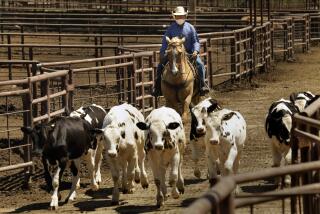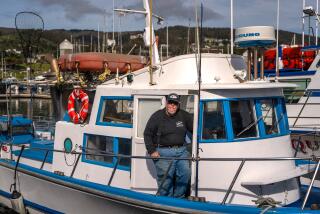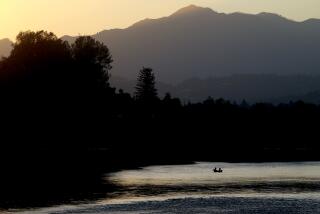The California Cook: An author’s instructive fishing expedition
It’s taken a while, but you think you’ve finally gotten a grasp on the issues related to where most of your food comes from. You’ve successfully parsed the gray areas among local, seasonal, organic, sustainable, no-spray and conventional. You know your carbon footprint from your food miles, and you shop at a farmers market when you’re not getting deliveries from your CSA.
Congratulations. Now what do you do about fish? Yeah, that’s what I thought. Me too.
As confusing as the arguments about produce might be, they’ve got nothing on seafood. That’s strictly the deep end of the pool, so to speak.
But here’s the thing: This stuff really matters, maybe even more than the questions about land-based foods. Even before the disaster in the Gulf of Mexico, the populations of some of the world’s most important food fish were balancing on a razor.
And there are few indications it will get better. Global per-capita consumption of seafood has more than doubled since the 1950s. And if we followed the advice of most nutritionists, we’d increase that amount by at least a third.
Yet there are few things in life more complicated than sorting through the various ethical implications of which fish you should be eating. We certainly can’t look to the fishermen themselves for restraint, if history is to be any judge. Their reaction to any proposed regulation tends to go in a straight line from “there is no problem” to “the problem is exaggerated” to “it’s somebody else’s problem,” winding up at “why didn’t you stop us earlier” only after the fishery has collapsed.
That’s why I’m so grateful to have “Four Fish,” a terrific new book by Paul Greenberg that helps explore some of those complexities. These days it seems like there is another food issues book coming out every five minutes, but if you’re going to read only one, this should be it.
Part of what makes the whole fish thing so complicated is simply that there are so many kinds, each with its own set of circumstances. That’s why the Monterey Bay Aquarium’s Seafood Choice wallet card is so handy — and also why seafood purists complain that even it is incomplete.
Here’s the L.A. Times Books section review of “Four Fish”:
Greenberg made a smart choice in writing the book by focusing on only four iconic fish, covering the basics of their biology and the history of their use by man, and then using them as launching points for further explorations.
So he starts with salmon, which leads into initial discussions of overfishing and then into aquaculture and its problems. Sea bass turns into a case study of how aquaculture can be done right. Cod is not only the emblematic story of a fishery gone bad but also how it can turn around … and just what “turning around” really means. Finally, tuna (especially bluefin) represents the current worst-case scenario, one from which, even with immediate action, recovery will be difficult.
FOR THE RECORD: An earlier version of this story stated that Greenberg spent time at an Aleut fishing camp in Alaska. He was at a Yu’Pik village in Alaska.
While the book is deeply researched and factual, it is by no means dry. In exploring these fish, Greenberg takes us to a Yu’Pik village in Alaska, to a “branzino” farm off a Greek island, to a barramundi farm in Australia and a tuna farm in Baja.
That may sound like a lot of fish farming, which, as we all know, is a bad thing. Well, maybe not. What makes the book work so well is that Greenberg is both an idealist and a realist. He doesn’t look at the problems of seafood from a narrow ideological perspective.
That’s crucial, particularly when it comes to fish, because they exist on multiple planes: Are they food or are they wildlife? Are they something that staves off starvation or are they a part of a vast ecosystem we’re just now beginning to understand? Though his eye is always on the ecological and biological implications of what is going on, he is also free of the cant that sometimes afflicts the true believer.
Aquaculture may be imperfect — and, at times, even hazardous — but given that the global population is growing rapidly and that people are demanding more and more fish to eat, do we have an alternative? Already farmed seafood accounts for almost half of global seafood consumption. That seems to be a bell that can’t be un-rung.
Rather than condemning fish farming because of the mistakes of the past — of which there have been plenty — Greenberg is willing to look at possible alternatives, praising them when they seem to be working (farming sea bass, for instance) and shooting them down when they fail (cod don’t seem to be economically viable for aquaculture, and farming tuna may actually take more fish out of the biomass than catching them does, since those fish are removed from the breeding pool).
There are a few things I wish Greenberg had addressed more thoroughly. He focuses mostly on saltwater fish, but so far it seems the most successful farms (ecologically anyway) have been freshwater — tilapia, catfish and the freshwater-saltwater hybrid that’s called “striped bass.” He mentions them, but mostly in passing.
Along the same lines, I wish Greenberg had paid more attention to shellfish — oysters and mussels have been successfully farmed for centuries, and amazingly, they improve the water quality of the area they’re in. Granted, he does visit a promising project in Nova Scotia that is combining the aquaculturing of salmon, mussels and seaweed in one spot, replicating something like a working ecosystem.
Finally, I wish he’d given a little love to small oily fishies such as anchovies, sardines and mackerel, some of my favorites. Not only are they delicious, but they reach maturity very quickly, meaning their populations are far more resilient to fishing pressures than those of big, slow-growing fish such as tuna. But heck, hardly anybody else pays much attention to them either.
Greenberg wraps up with short outlines of ideas to guide how we should be thinking about managing both global fisheries in general and aquaculture specifically.
The first includes some radical proposals: reducing the size of the world fishing fleet, converting large areas of the oceans to no-catch zones to enable fish populations to replenish, establishing global rules to protect far-ranging species, and protecting the “bottom of the food chain” animals that are now being used mostly for fish feed for aquaculture.
When it comes to farming, his guidelines seem much more immediately doable: emphasize fish and systems that can be grown most efficiently with the least destruction to the wild environment, and think more about polyculture rather than monoculture — growing several complementary species on a single farm rather than just one.
As Greenberg points out, why should ocean farming repeat the mistakes of land farming?
Sustainable seafood dinner at Ammo
Paul Greenberg, author of “Four Fish,” will hold a book signing and dinner at Ammo on Aug. 8. The Sunday night meal will feature four courses of sustainable seafood: oysters on the half shell; kampachi with avocado, chile and lime; oven-roasted mussels and clams with shell beans and fennel; and a choice of smoked arctic char with lemon cucumber and tomato salad, or grilled barramundi with caponata. Dessert will be roasted figs with honey ice cream. The meal will be $50, and books will be available for signing. Ammo, 1155 N. Highland Ave., L.A.; (323) 871-2666; https://www.ammocafe.com.
More to Read
Eat your way across L.A.
Get our weekly Tasting Notes newsletter for reviews, news and more.
You may occasionally receive promotional content from the Los Angeles Times.







